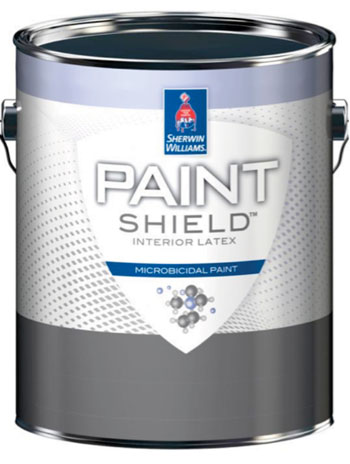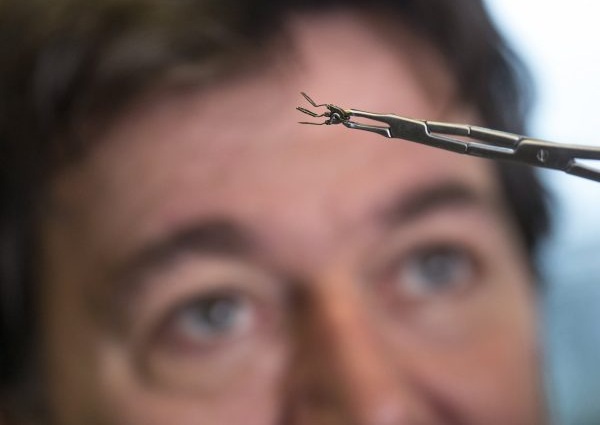Microbicidal Paint Kills Infection-Causing Bacteria
|
By HospiMedica International staff writers Posted on 16 Nov 2015 |

Image: Sherwin-Williams Paint Shield interior paint (Photo courtesy of Sherwin-Williams).
Innovative latex paint available in 590 colors has the power to kill bacteria continuously just two hours after contact.
Paint Shield is a new interior paint that can be applied to any hard, non-porous surface, including ceilings, walls, doors, and trim. The active component is a quaternary ammonium (quat) compound called alkyldimethy-lbenzylammonium chloride (ADBAC), which is suspended in the paint without compromising its integrity thanks to a patented formulation that ensures its stability in the coating. Paint Shield glides on like regular paint and is applied just like any other paint using rollers, a brush, or by spraying.
In clinical tests, Paint Shield was shown to kill 99.9% of Staphylococcus aureus, Methicillin-resistant Staphylococcus aureus (MRSA), E. coli, Vancomycin-resistant Enterococcus faecalis (VRE), and Enterobacter aerogenes bacteria two hours after exposure. Once applied, it keeps killing germs for up to four years. Paint Shield is a product of Sherwin-Williams (Cleveland, OH, USA), and is intended for a variety of settings such as healthcare facilities, athletic facilities, schools, day care centers, senior care communities, residential housing, hospitality settings, and cruise ships.
“Paint Shield is one of the most significant technological breakthroughs in our nearly 150-year history of innovation,” said Chris Connor, chairman and CEO of Sherwin-Williams. “By killing infectious pathogens on painted surfaces, Paint Shield is a game-changing advancement in coatings technology.”
“Other manufacturers put additives into paints to prevent bacteria from spreading and call it antimicrobial paint,” said Steve Revnew, senior vice president of product innovation at Sherwin-Williams. “Sherwin-Williams' product is differentiated, kills bacteria on the surface after two hours, instead of simply preventing the organisms from corroding the paint as antimicrobial products do. As you can well imagine, there’s quite a bit of need in this market.”
ADBAC is an organic salt that has three main categories of use: as a biocide, a cationic surfactant, and phase transfer agent. It’s antimicrobial activity has led to it being used as an active ingredient in many consumer products, including eye, ear, and nasal drops; in hand sanitizers, wet wipes, shampoos, deodorants, and cosmetics; as a skin antiseptic; and for commercial uses such as spray disinfectants for hard surface sanitization (Lysol) and for clearing of algae, moss, and lichens from paths, roof tiles, swimming pools, masonry, etc.
Related Links:
Sherwin-Williams
Paint Shield is a new interior paint that can be applied to any hard, non-porous surface, including ceilings, walls, doors, and trim. The active component is a quaternary ammonium (quat) compound called alkyldimethy-lbenzylammonium chloride (ADBAC), which is suspended in the paint without compromising its integrity thanks to a patented formulation that ensures its stability in the coating. Paint Shield glides on like regular paint and is applied just like any other paint using rollers, a brush, or by spraying.
In clinical tests, Paint Shield was shown to kill 99.9% of Staphylococcus aureus, Methicillin-resistant Staphylococcus aureus (MRSA), E. coli, Vancomycin-resistant Enterococcus faecalis (VRE), and Enterobacter aerogenes bacteria two hours after exposure. Once applied, it keeps killing germs for up to four years. Paint Shield is a product of Sherwin-Williams (Cleveland, OH, USA), and is intended for a variety of settings such as healthcare facilities, athletic facilities, schools, day care centers, senior care communities, residential housing, hospitality settings, and cruise ships.
“Paint Shield is one of the most significant technological breakthroughs in our nearly 150-year history of innovation,” said Chris Connor, chairman and CEO of Sherwin-Williams. “By killing infectious pathogens on painted surfaces, Paint Shield is a game-changing advancement in coatings technology.”
“Other manufacturers put additives into paints to prevent bacteria from spreading and call it antimicrobial paint,” said Steve Revnew, senior vice president of product innovation at Sherwin-Williams. “Sherwin-Williams' product is differentiated, kills bacteria on the surface after two hours, instead of simply preventing the organisms from corroding the paint as antimicrobial products do. As you can well imagine, there’s quite a bit of need in this market.”
ADBAC is an organic salt that has three main categories of use: as a biocide, a cationic surfactant, and phase transfer agent. It’s antimicrobial activity has led to it being used as an active ingredient in many consumer products, including eye, ear, and nasal drops; in hand sanitizers, wet wipes, shampoos, deodorants, and cosmetics; as a skin antiseptic; and for commercial uses such as spray disinfectants for hard surface sanitization (Lysol) and for clearing of algae, moss, and lichens from paths, roof tiles, swimming pools, masonry, etc.
Related Links:
Sherwin-Williams
Latest Critical Care News
- AI Interpretability Tool for Photographed ECG Images Offers Pixel-Level Precision
- AI-ECG Tools Can Identify Heart Muscle Weakness in Women Before Pregnancy
- AI Model Analyzes Patient Data to Diagnose Multiple Sclerosis With 90% Accuracy
- Magnetically Navigable Microparticles Enable Targeted Drug Delivery
- AI-Powered Algorithm Automates Analysis of Coronary Stents After Implantation
- New Stroke Risk Scoring System to Help Avoid Unnecessary Surgeries
- Wearable Device Tracks Individual Cells in Bloodstream in Real Time
- Drug Delivery System Uses Ultrasound-Activated Nanoparticles to Destroy Bacterial Biofilms
- New Potent Injectable Therapy Could Prevent Heart Failure After Heart Attack
- Hospital-Based System Combines AI and Genomic Surveillance to Quickly Detect Infectious Disease Outbreaks
- New Approach to Visualizing Blood Pressure Data Can Help Better Manage Hypertension Patients
- Breakthrough AI Technology Accurately Assesses Heart Failure Severity
- Smart Bandage Monitors Chronic Wounds in Human Patients
- AI Identifies Patients with Increased Lung Cancer Risk Up To 4 Months Earlier
- Next Gen Hemodynamic Monitoring Solution Provides AI-Driven Clinical Decision Support
- AI Algorithm Identifies High-Risk Heart Patients
Channels
Surgical Techniques
view channel
New Procedure Found Safe and Effective for Patients Undergoing Transcatheter Mitral Valve Replacement
In the United States, approximately four million people suffer from mitral valve regurgitation, the most common type of heart valve disease. As an alternative to open-heart surgery, transcatheter mitral... Read more
No-Touch Vein Harvesting Reduces Graft Failure Risk for Heart Bypass Patients
A coronary artery bypass graft (CABG) is a surgical procedure used to enhance blood flow and oxygen supply to the heart in individuals with coronary heart disease. During the procedure, a healthy blood... Read more
DNA Origami Improves Imaging of Dense Pancreatic Tissue for Cancer Detection and Treatment
One of the challenges of fighting pancreatic cancer is finding ways to penetrate the organ’s dense tissue to define the margins between malignant and normal tissue. Now, a new study uses DNA origami structures... Read morePatient Care
view channel
Portable Biosensor Platform to Reduce Hospital-Acquired Infections
Approximately 4 million patients in the European Union acquire healthcare-associated infections (HAIs) or nosocomial infections each year, with around 37,000 deaths directly resulting from these infections,... Read moreFirst-Of-Its-Kind Portable Germicidal Light Technology Disinfects High-Touch Clinical Surfaces in Seconds
Reducing healthcare-acquired infections (HAIs) remains a pressing issue within global healthcare systems. In the United States alone, 1.7 million patients contract HAIs annually, leading to approximately... Read more
Surgical Capacity Optimization Solution Helps Hospitals Boost OR Utilization
An innovative solution has the capability to transform surgical capacity utilization by targeting the root cause of surgical block time inefficiencies. Fujitsu Limited’s (Tokyo, Japan) Surgical Capacity... Read more
Game-Changing Innovation in Surgical Instrument Sterilization Significantly Improves OR Throughput
A groundbreaking innovation enables hospitals to significantly improve instrument processing time and throughput in operating rooms (ORs) and sterile processing departments. Turbett Surgical, Inc.... Read moreHealth IT
view channel
Printable Molecule-Selective Nanoparticles Enable Mass Production of Wearable Biosensors
The future of medicine is likely to focus on the personalization of healthcare—understanding exactly what an individual requires and delivering the appropriate combination of nutrients, metabolites, and... Read more
Smartwatches Could Detect Congestive Heart Failure
Diagnosing congestive heart failure (CHF) typically requires expensive and time-consuming imaging techniques like echocardiography, also known as cardiac ultrasound. Previously, detecting CHF by analyzing... Read moreBusiness
view channel
Expanded Collaboration to Transform OR Technology Through AI and Automation
The expansion of an existing collaboration between three leading companies aims to develop artificial intelligence (AI)-driven solutions for smart operating rooms with sophisticated monitoring and automation.... Read more















